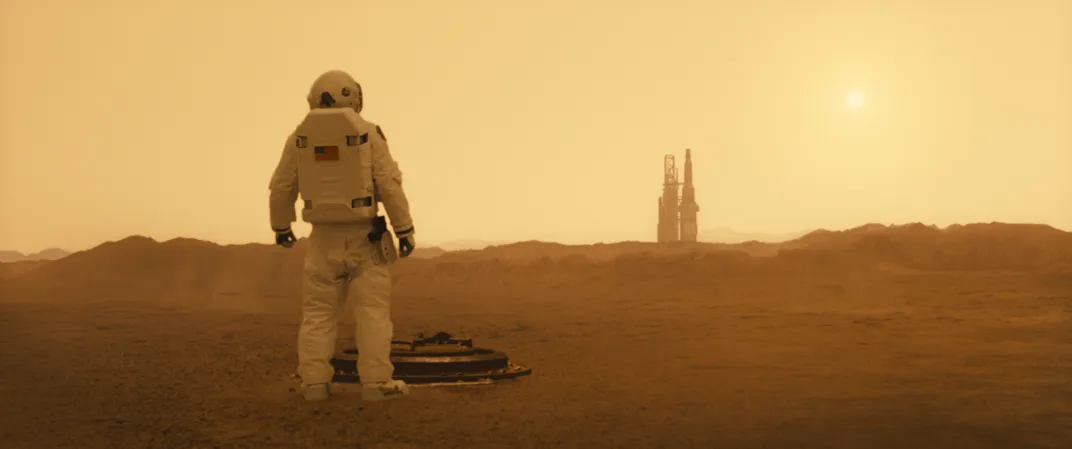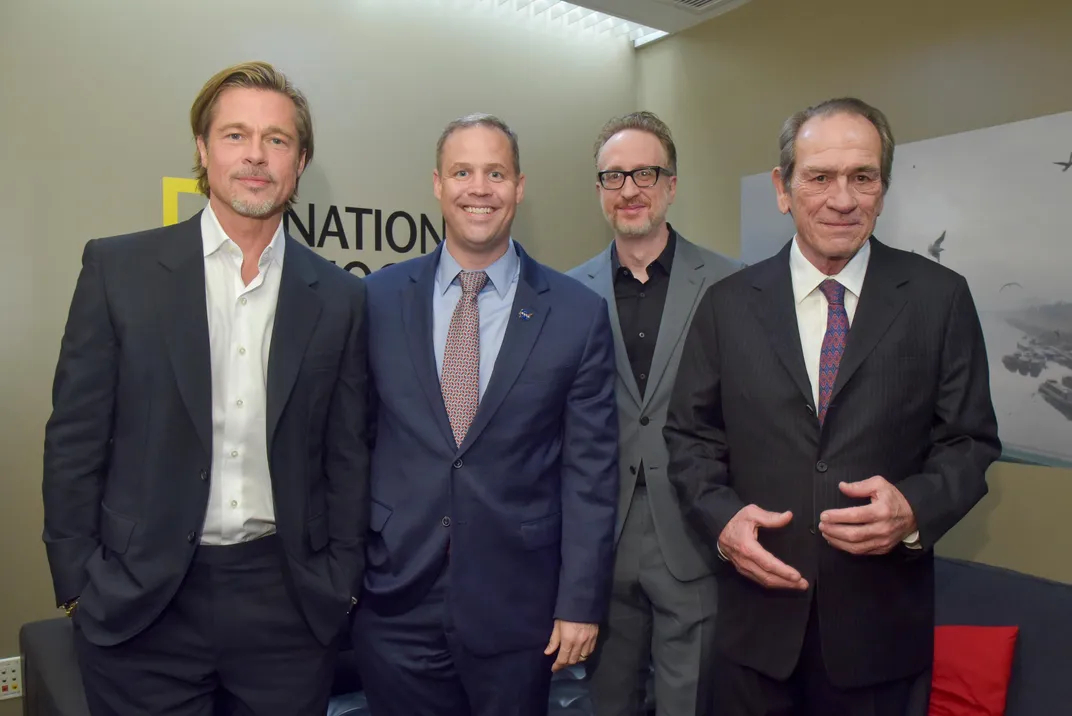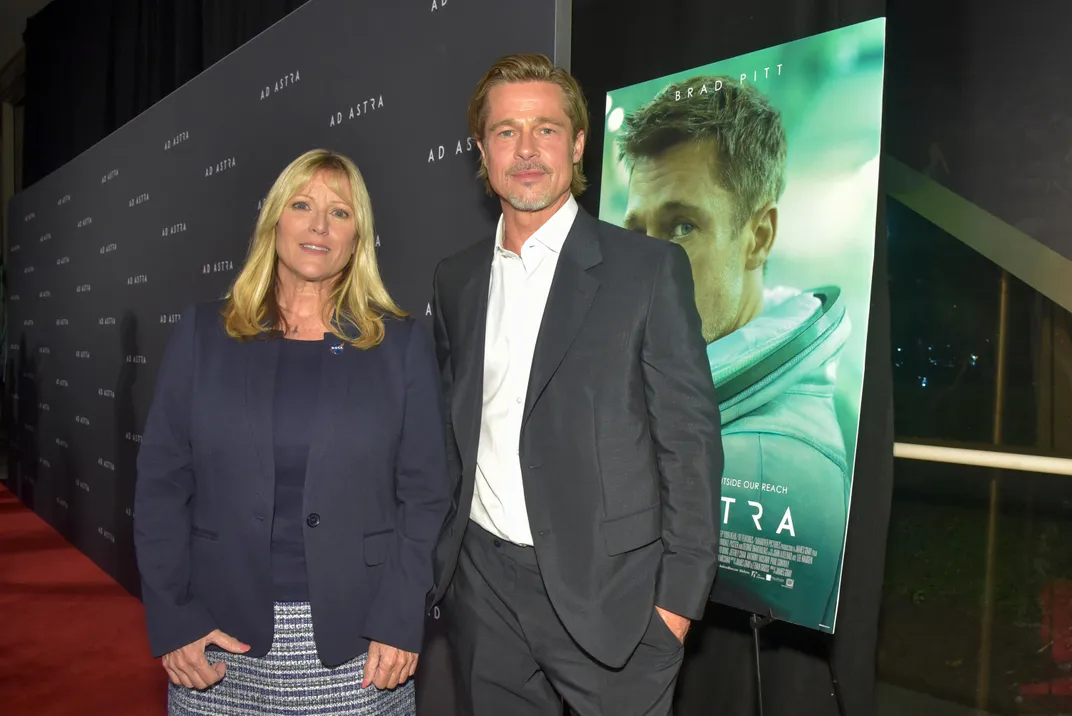With the New Movie Ad Astra, James Gray and Brad Pitt Offer a “Plausible” Vision of Late-21st Century Space Travel
Shuttle astronaut Garrett Reisman helped writer-director Gray make his space adventure authentic(ish).
/https://tf-cmsv2-smithsonianmag-media.s3.amazonaws.com/filer/e1/74/e174a06d-e63f-4d10-bcbe-37bab17725a7/ad-astra-df-03911fd_r.jpg)
In the new science-fiction film Ad Astra, Brad Pitt plays Roy McBride, an astronaut sent on a secret mission some unspecified number of decades in the future. Energy pulses emanating from Neptune’s orbit are wreaking havoc on Earth, and McBride’s superiors in the U.S. Space Command suspect these dangerous anomalies might be connected to an exploration mission captained by McBride’s father (played by Tommy Lee Jones), with whom they lost contact some 16 years in the past.
At an event at the Washington Post earlier this week, Post film critic Ann Hornaday moderated a one-hour conversation among Ad Astra producer/star Pitt, writer/director James Gray, and two NASA officials—Sarah Noble, Lunar Scientist, and Lindsay Aitchison, Exploration Extravehicular Activity (EVA) Strategy Lead (read: spacesuit expert). The broad subject of the conversation was the filmmakers’ attempts to create a plausible vision of how the technical, commercial, and political circumstances of space travel might have developed by the mid-to-late 21st century. Noble and Aitchison spoke about how NASA’s current lunar initiatives, including the Artemis program, which aims to return astronauts to the surface by 2024, could point the way to such a future.
Similar in spirit to 1968’s 2001: A Space Odyssey, the new movie imagines Virgin Atlantic flights to the moon’s tourist-tamed regions (complete with chain restaurants and sounvenir stands) and pirate raids on lunar convoys in its violently contested terriorties. Whether it’s Helium 3 or some other precious natural resource, every nation-state, corporation, and extra-legal party wants a piece of the (moon) pie. Ad Astra also imagines rocket launches from the moon to reach Mars, which has become the site of a permanent human outpost, most of it underground.

Gray told Hornaday that he and his collaborators aimed for plausibility rather than realism, veering away from strict adherence to science where the story demanded it. “You can study Buzz Aldrin's orbital mechanics dissertation, but in the end, you have to know it so that you can forget about it,” Gray said. Pitt added that he was attracted to the idea of depicting spaceflight as a banal, uncomfortable experience, but freely admitted that he relied upon Gray and cinematograher Hoyte Van Hoytema (who also shot the deep-space adventure Interstellar) to give the film versimilitude, preferring to focus on his own performance. He’s in every scene, and he’s often alone.
In fact, solitude—solitude of the species, anyway—is the movie’s theme. While the film depicts a long-term search for extraterrestrial life, its guiding principle is “No false gods,” Gray told Hornaday. “No one is going to save us. No green man is going to help us out of climate change or anything like that. No bad aliens are going to come unify the whole planet and make us realize we’re all the same. They’re not coming.”
While the film depicts some of the potential undesirable consequences of an expanded human presence on the moon and in space, Gray said he was “a fan” of crewed exploration, noting that he kept a photo of Apollo 11 crewmembers Neil Armstrong, Buzz Aldrin, and Mike Collins posted to his bedroom wall as as kid. (The filmmaker was three months old when their Lunar Module touched down on July 20, 1969.) He also said he’d befriended Garrett Reisman, a veteran of three Space Shuttle missions, and relied on him for informal technical advice while working on the film. The day after he screened Ad Astra for Riesman, Gray said, he received “a two billion word email, very complimentary for the most part” wherein Riesman proceeded to enumerate the movie’s errors and implausibilities. “It hurts,” Gray admitted.

Called on to describe NASA’s Artemis program, Noble talked about the necessity of visiting the moon’s South Pole to locate resources, including water. “We know that there are minerals we didn’t sample during Apollo, because they’re only in specific places on the moon,” Noble said. She also discussed how the permanent lunar Gateway craft orbiting the moon, currently scheduled for launch in 2022, will give astronauts access to the entirety of the moon’s surface as well as serving as a staging area for an eventual Mars mission.
Hornaday then asked Noble and Aitcheson if they ever discuss one of the ideas presented in Ad Astra and other science fiction stories: As humankind gradually expands its footprint beyond Earth, “what if we export the same problems that we haven’t solved here?”
“Then you’re just admitting defeat, and we’re never going to go anywhere,” Noble replied, pointing out that technologies refined on the moon might be used to mitigate some of Earth’s woes.

While the movie certainly takes a dour view of the potential for unchecked lunar commerce many years in the future, Noble and Aitchison resisted the notion that getting private companies involved could be dangerous. Noble talked about how former Google X-Prize contenders will soon be hauling cargo to the surface for NASA. And Aitchison credited Elon Musk with reigniting public interest in space. “As an engineer, I get excited about innovative ideas. I don’t care where they come from,” Aitchison said. When Hornaday asked her if NASA equipment designers ever get ideas from sci-fi movies, Aitchison pivoted skillfully, mentioning a dress she saw on the MTV Video Music Awards that featured text messages scrolling across its fabric. She wondered aloud if a similar capability might be developed for the sleeve of a spacesuit.

As Hornaday attempted to bring the event to a close, the movie star asked her if he could ask a final question. He turned to the NASA scientists to his left to ask whether he or Solaris and Gravity star George Clooney had played the more believable astronaut. After Noble and Aitchison smiled and shook their heads, Pitt quipped, “It was Matt Damon.”
A video of the event is archived below. Ad Astra opens in theatres today.

